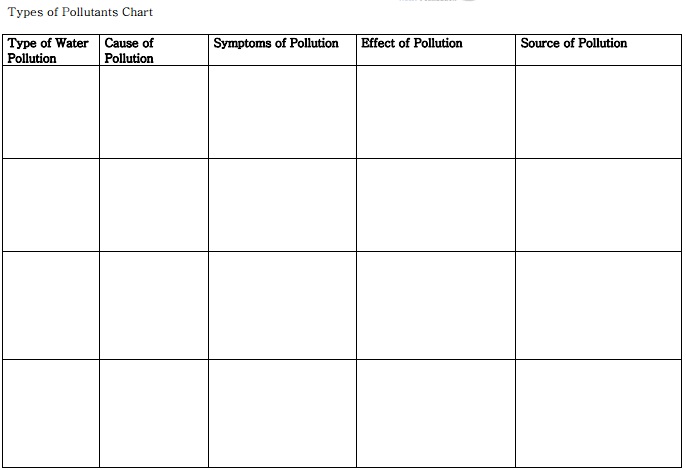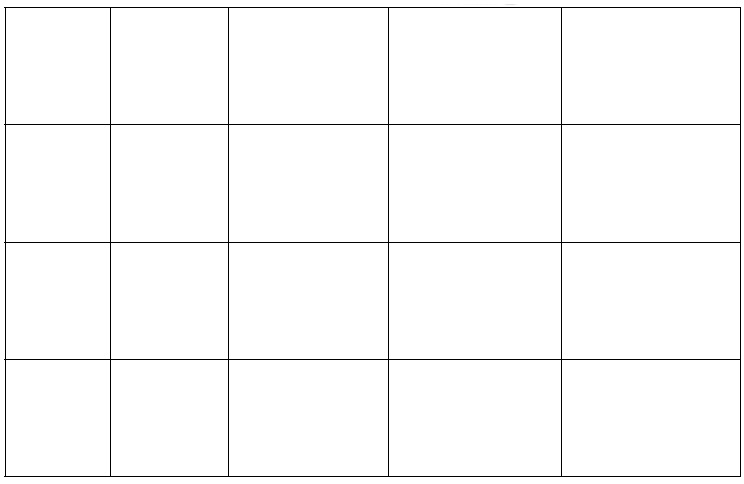Grades 5-12 (Science and Social studies)
Topic: The different types of water pollution
Time: 60 minutes
Space Requirement: Regular classroom
Methodology: Jigsaw, cooperative learning, group presentations
Materials: small glass jars or doubled-up ziplock bags for water samples, powdered laundry detergent, hot water, dirt, Tylenol or aspirin, and completed charts (1/student)
Objectives: The students will determine the different types of water pollution. They will also identify ways water pollution spreads.
Directions/Procedure:
Before the lesson, prepare the following water samples:
a. Add some powdered laundry detergent to water and mix (for nitrates and phosphates)
b. Warm up some water (for the thermal pollution)
c. Add some fine sand or soil to water and mix (for sedimentation)
d. Add two Tylenol or Aspirin to some water and mix (for medicinal pollutants)Explain the activity for the class (5 min)
a. Students will be divided into groups of at least three. Each group is responsible for learning about that type of water pollution.
b. Each group will make a short presentation to the class and they will pass around a sealed sample of that type of pollution (when applicable)Divide the class into groups and get them working on the materials (20 min)
a. Each group should designate one person to read the information out loud, one person to make important notes and one person to gather the sample if there is one and write out the information into the chart on the board.
b. Each group must present the information they have learned to the class. They can pass around the sample if they have one.Each group makes a short presentation (no more than 5 minutes) on the type of water pollution they looked at. (20 min)
After the last presentation, when the chart is filled, have the class discuss what they have learned about the types of water pollution by having the students write down on a separate sheet of paper their first hand experience of water pollution (where it was, what type, probable source). The students have the rest of the class to work on this writing assignment. Tell the students it will be handed in the next day. (15 min)
Remind the students to fill in their water bottle charts.
Make copies of the completed chart (see Resources) for the students the next day.
Evaluation: The cooperation among the group members and the presentation are useful criteria for evaluating the depth of understanding of the students. The writing assignment is useful for assessment purposes.
For the Teacher: This activity allows students to investigate the types of water pollution. Each group must have at least one copy of the fact sheet/hand out for that particular type of water pollution. A blank chart is available to be printed off for students to fill in or a completed chart is also available for students to get the day after the lesson. The effect and source columns might remain blank for some groups but this will be filled in during the next lesson. In some cases, samples of water pollution will be available but not for hazard wastes or sewage/manure.
The water samples should be prepared in advance (as much as a day except for the hot water). These samples are designed to give students a visual cue as to what the pollution looks and feels like. They are not to be consumed under any circumstances.
Related Links:
Resources: The complete Types of Water Pollution handout. The blank and completed chart is available below.
Extension Activity: The Safe Drinking Water Foundation has other educational programs that can be taught with this set of lessons. Operation Water Drop looks at what chemical contaminants there are in water and is designed for a science class. Operation Water Flow looks at how water is used and where it comes from and is designed for a Social studies and Math collaboration. Operation Water Spirit presents a First Nations perspective of water and water issues and is designed for a Native Studies class. Operation Water Health looks at common health issues surrounding drinking water in Canada and around the world and is designed for a Health, Science and Social Studies collaboration. To access more information on these and other educational activities visit the Safe Drinking Water Foundation website at www.safewater.org.




